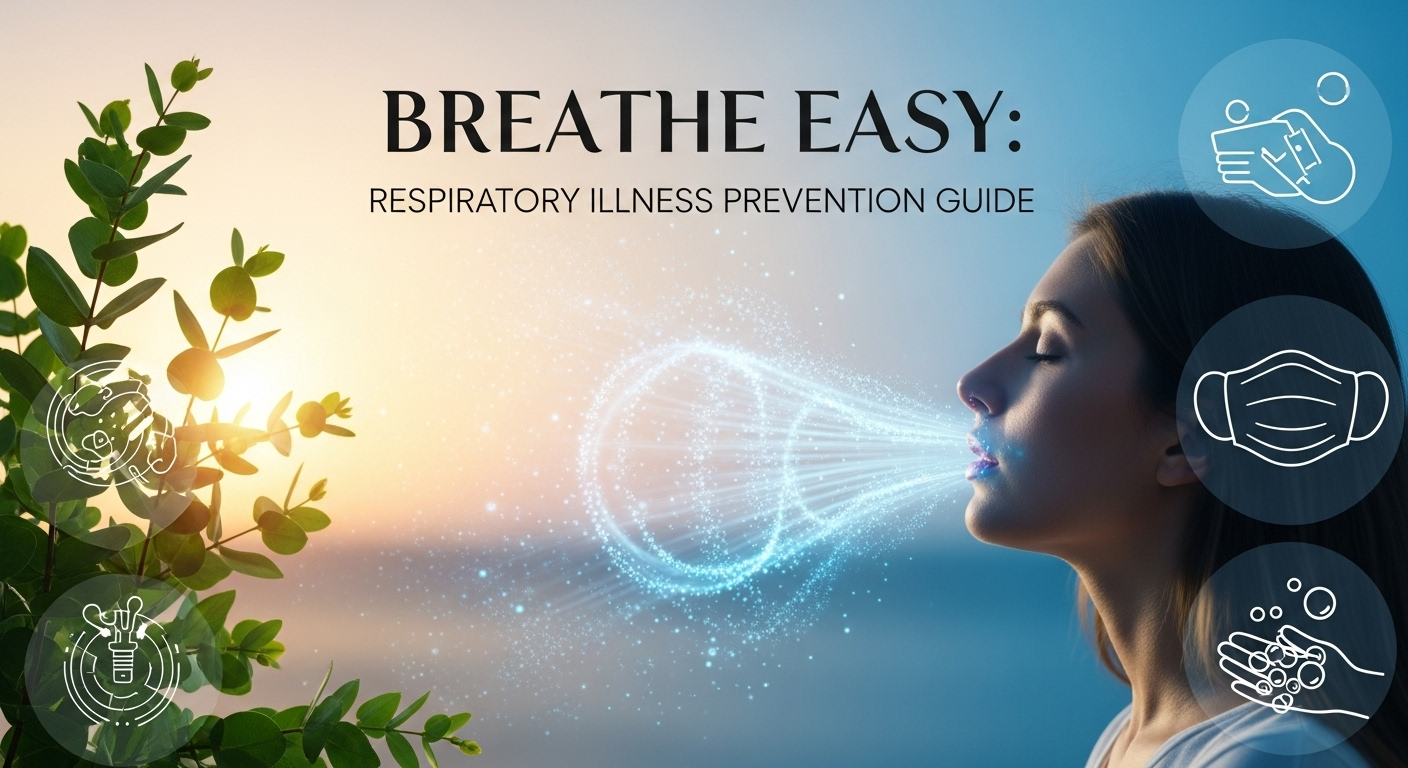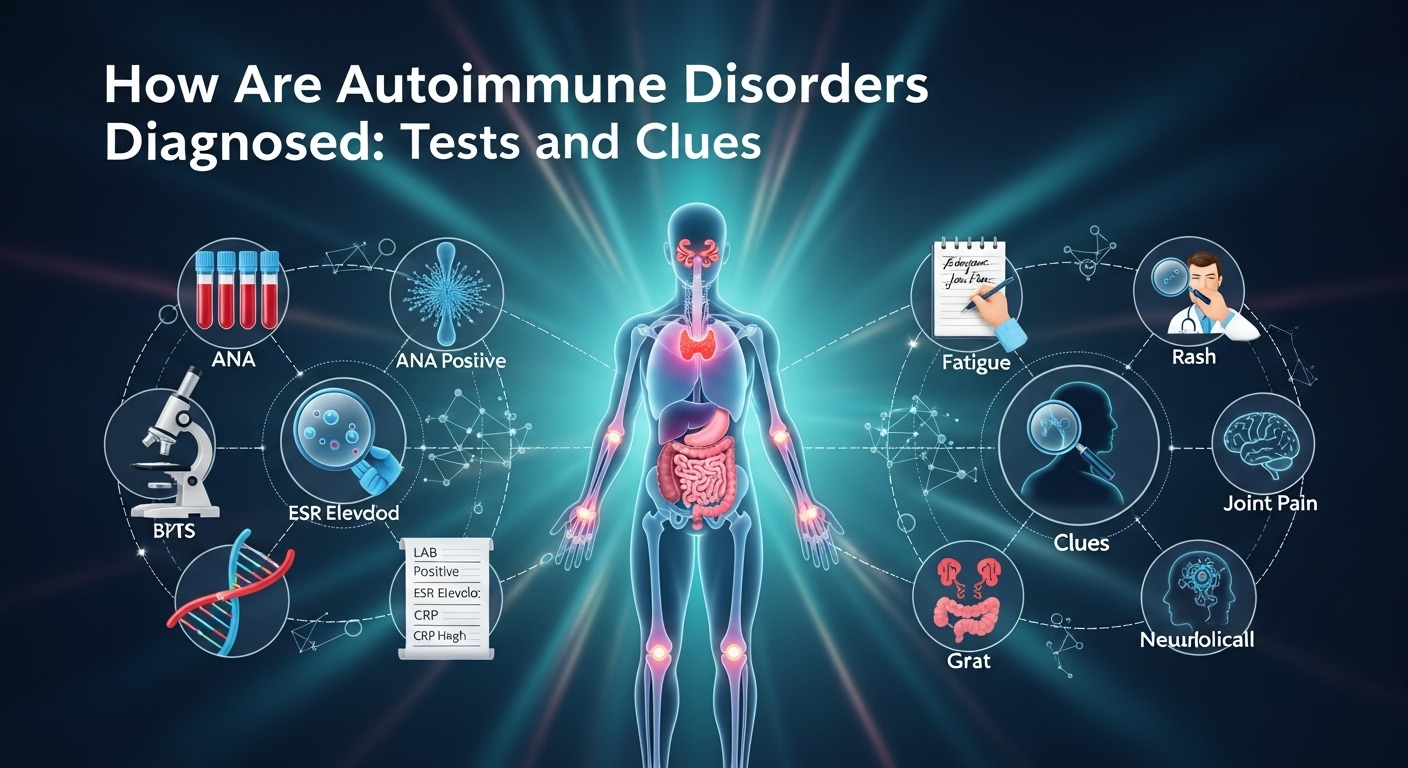In an ideal world, every breath we take would be clean, fresh, and invigorating. However, reality presents a landscape filled with invisible challenges: viruses, bacteria, pollutants, and allergens, all waiting for an opportunity to compromise our respiratory system. From the common cold that disrupts a work week to more serious conditions like influenza or pneumonia, respiratory illnesses are a persistent threat to our well-being. The good news is that we are not defenseless. By adopting a proactive and informed approach, you can significantly reduce your risk and fortify your body's natural defenses. These comprehensive prevention tips for respiratory illnesses are your best defense, serving as a practical guide to help you and your family navigate the seasons with greater confidence and health. This guide will empower you with the knowledge to build a resilient respiratory system, one healthy habit at a time. Breathe Easy: A Comprehensive Respiratory Illness Prevention Guide The Cornerstone of Prevention: Mastering Personal Hygiene The first line of defense against respiratory pathogens is not a complex medical procedure or an expensive supplement; it’s the consistent practice of good personal hygiene. Most respiratory viruses and bacteria are transmitted through droplets released when an infected person coughs, sneezes, or talks. These droplets can either be inhaled directly or can land on surfaces, where they can be picked up by our hands. From there, it’s a short trip to our eyes, nose, or mouth—the primary gateways for germs to enter the body. Therefore, mastering simple yet powerful hygiene habits is the single most effective, low-cost strategy to interrupt this chain of transmission. This isn't just about what you do when you feel sick; it’s about creating a daily routine that protects you and those around you. Think of it as building a shield. Every time you wash your hands correctly or cover a cough, you are reinforcing that shield, making it harder for opportunistic germs to find a way in. Consistency is the key. A single instance of forgetting to wash your hands after touching a public doorknob could be the one that leads to infection. By internalizing these practices, you transform them from conscious efforts into second nature, creating a formidable barrier against a wide array of respiratory illnesses. The profound impact of hygiene was demonstrated on a global scale during the COVID-19 pandemic, but its principles have been a cornerstone of public health for over a century. It's a testament to the fact that the simplest actions often yield the most significant results. Integrating these habits into your life doesn't just protect you during flu season or an outbreak; it provides year-round protection against countless pathogens, ensuring your respiratory system remains as healthy as possible. The Art of Effective Handwashing Handwashing is more than a quick rinse under the tap. To be effective, it must be thorough. The U.S. Centers for Disease Control and Prevention (CDC) recommends washing with soap and water for at least 20 seconds—roughly the time it takes to sing the “Happy Birthday” song twice. The friction from scrubbing, combined with the chemical properties of soap, works to break down the lipid envelope that surrounds many viruses, including influenza and coronaviruses, rendering them inactive and easily washed away. Make it a non-negotiable routine to wash your hands at critical moments: Before preparing or eating food. After using the restroom. After returning home from a public place (grocery store, office, public transport). After blowing your nose, coughing, or sneezing. Before and after caring for someone who is sick. When soap and water are not available, an alcohol-based hand sanitizer with at least 60% alcohol is a suitable alternative. Apply enough sanitizer to cover all surfaces of your hands and rub them together until they are dry. Mastering Respiratory Etiquette When you cough or sneeze, you can project respiratory droplets several feet. If you are infectious (even without knowing it), you are actively spreading germs into the air and onto surfaces. The best practice is to always cover your mouth and nose with a tissue, and then immediately dispose of the tissue in a closed bin. If a tissue isn’t available, cough or sneeze into the crook of your elbow, not into your hands. This simple act prevents you from contaminating your hands, which are a primary vehicle for spreading germs to other surfaces and people. Teaching this "vampire cough" to children from a young age is an excellent way to instill lifelong healthy habits. Furthermore, during periods of high community transmission of illnesses like the flu or COVID-19, wearing a high-quality, well-fitting mask in crowded indoor spaces provides an additional layer of protection, both for you and for others. It contains your own respiratory droplets and filters the air you breathe in, significantly reducing the likelihood of transmission. Avoid Touching Your Face: The T-Zone Rule The average person touches their face dozens, if not hundreds, of times per hour, often without even realizing it. This subconscious habit is a direct route for germs from your hands to enter your body. Your eyes, nose, and mouth form what is often called the “T-Zone,” the mucous membranes that are most vulnerable to infection. Even with diligent handwashing, you can pick up germs between washes. Therefore, making a conscious effort to keep your hands away from your T-Zone is a critical preventative measure. Breaking this habit can be challenging. Start by simply becoming aware of how often you do it. Place sticky notes on your computer monitor or desk as a reminder. If you have an itch on your face, try to use a clean tissue instead of your bare fingers. Reducing face-touching effectively closes one of the most common entry points for respiratory pathogens, complementing your hand hygiene efforts and making your overall defense strategy much more robust. Bolstering Your Body's Natural Defenses: The Immune System While external barriers like hygiene are crucial, your ultimate protection against respiratory illness comes from within: your immune system. This complex network of cells, tissues, and organs works tirelessly to identify
How to Build Muscle Mass After 40: A Complete Guide
Hitting your 40s often comes with a new perspective on health and fitness. The carefree metabolism of your 20s may feel like a distant memory, and you might notice that maintaining, let alone building, muscle is becoming a tougher challenge. You're not imagining it. Biological changes, including hormonal shifts and a natural decline in muscle synthesis, make the process different. However, the idea that your best physical years are behind you is a myth. The key to success lies in a smarter, more strategic approach. This comprehensive guide will show you exactly how to build muscle mass after 40, proving that age is truly just a number when armed with the right knowledge and dedication. Understanding the "Over 40" Challenge: Sarcopenia and Hormonal Shifts Before diving into the "how," it's crucial to understand the "why." Why does building muscle feel different after 40? The primary culprit is a process called sarcopenia, the age-related involuntary loss of muscle mass, strength, and function. This process can begin as early as your 30s and accelerates with each passing decade if left unchecked. It's a natural part of aging, but "natural" does not mean it's uncontrollable. Resistance training is the single most effective antidote to sarcopenia, sending a powerful signal to your body to preserve and build new muscle tissue. Hormonal changes also play a significant role. For men, testosterone levels, a key hormone for muscle protein synthesis, begin a slow and steady decline. For women, the approach of perimenopause and menopause brings fluctuations and an eventual drop in estrogen and progesterone. These hormones do more than just regulate reproductive health; they also influence muscle repair, bone density, and fat distribution. A decrease in these hormones can make it harder to recover from workouts and easier to store fat, creating a more challenging environment for muscle growth. However, this is not a doomsday scenario. It’s simply a change in the rules of the game. Your body is still incredibly capable of adapting and growing stronger. Understanding these biological shifts allows you to work with your body, not against it. It means your training, nutrition, and recovery must be more intentional and precise than ever before. With a strategic plan, you can effectively counteract these changes and build a stronger, more resilient physique than you had in your younger years. The Foundation: Progressive Overload and Strategic Strength Training If there is a single, non-negotiable principle for building muscle at any age, it is progressive overload. This principle states that for a muscle to grow, it must be forced to adapt to a tension that is above and beyond what it has previously experienced. After 40, this principle becomes even more critical. Your body requires a clear and consistent signal that muscle is not a "luxury" it can afford to lose but a "necessity" it must build to meet the demands you place on it. Without progressive overload, your workouts are simply exercise, not training. Simply going to the gym and lifting the same weights for the same number of reps week after week will lead to a plateau. To create the stimulus for growth, you must systematically increase the challenge over time. This can be achieved in several ways: increasing the weight you lift, performing more repetitions or sets with the same weight, reducing rest times between sets, or improving your form and range of motion. The goal is consistent, measurable progress, no matter how small. The foundation of your muscle-building program should be built around strength training, specifically using resistance. While cardiovascular exercise is vital for heart health, it does not provide the specific stimulus needed for significant muscle hypertrophy (growth). A well-structured strength training routine, performed consistently 2-4 times per week, is the cornerstone of how to build muscle mass after 40. Choosing the Right Exercises The most efficient way to structure your workouts is by prioritizing compound movements. These are multi-joint exercises that work several muscle groups simultaneously. Think of them as the biggest "bang for your buck" exercises. Examples include squats, deadlifts, bench presses, overhead presses, pull-ups, and rows. They trigger a greater hormonal response (including growth hormone and testosterone) and burn more calories compared to isolation exercises, making them incredibly effective for overall strength and muscle development. While compound lifts should form the core of your program (about 80%), isolation exercises also have their place. These single-joint movements, such as bicep curls, tricep extensions, and leg extensions, are excellent for targeting specific muscles that may be lagging or for adding extra volume to a muscle group without overly taxing your central nervous system. A balanced program incorporates both. For example, a workout might start with heavy squats (compound), followed by lunges (compound/accessory), and finish with leg curls and calf raises (isolation). Structuring Your Workouts for Longevity As you age, recovery becomes just as important as the workout itself. Overtraining is a real risk and can lead to injury, burnout, and stalled progress. Therefore, structuring your weekly routine to allow for adequate rest is paramount. For many people over 40, a full-body routine performed three times a week on non-consecutive days (e.g., Monday, Wednesday, Friday) is an excellent choice. This frequency allows you to stimulate all major muscle groups multiple times per week while providing 48 hours of recovery between sessions for repair and growth. Alternatively, you could opt for a split routine, such as an "Upper/Lower" split. This involves training the upper body on one day and the lower body on another, often performed over four days a week (e.g., Upper, Lower, Rest, Upper, Lower). This allows for more volume and focus on individual muscle groups per session but requires a greater weekly time commitment. The best split is the one you can adhere to consistently. The key is to listen to your body—if you feel constantly sore, fatigued, or your performance is declining, you may need an extra rest day. Fueling the Machine: Nutrition for Muscle Growth After 40 You can have the most perfectly designed workout program
Hidden causes of chronic inflammation in the body, explained
Hidden causes of chronic inflammation in the body, explained. Chronic inflammation is often silent, systemic, and surprisingly common—and it can drive fatigue, weight plateaus, brain fog, and long-term disease risk. While most of us connect inflammation with obvious triggers like injury or infection, the real picture is more nuanced. There are multiple, often hidden, causes of chronic inflammation in the body that accumulate over time and create an “always-on” immune signal. The good news: understanding these root causes helps you make practical, sustainable changes that tame inflammation without extreme measures. Below, we unpack the science, decode the less obvious triggers, and share evidence-aligned steps to measure and manage chronic inflammation for the long haul. The biology of chronic inflammation: why “low-grade” doesn’t mean low-impact Immune signaling 101: how an ancient alarm goes modern Your immune system evolved to react fast—neutralize threats, clear damage, and restore balance. In acute inflammation (like a cut or a cold), immune cells release cytokines (such as IL‑6, TNF‑α, and IL‑1β) that recruit help, increase blood flow, and spark tissue repair. When the job is done, anti-inflammatory pathways switch on to resolve the response. Chronic inflammation happens when that resolution phase is incomplete or repeatedly interrupted. Low levels of pro-inflammatory signals persist in the background—enough to nudge metabolism, hormones, and neural circuits out of sync. Over months and years, that “low-grade” signal can contribute to insulin resistance, arterial plaque instability, accelerated joint wear, and neuroinflammatory changes that influence mood and cognition. Think of the immune system as a thermostat. Acute inflammation is a short blast of heat in winter; chronic inflammation is a furnace stuck on a low setting year-round. The body adapts, but there’s ongoing “wear” on tissues, energy systems, and even mitochondrial function. Acute vs. chronic: key differences you can feel (and test) Acute inflammation is typically obvious—pain, swelling, warmth, redness, fever. Chronic inflammation is subtler: you might feel vague tiredness, non-restorative sleep, slow workout recovery, frequent sugar cravings, or persistent “puffy” stiffness on waking. Many people also notice brain fog, lower stress tolerance, or a cycle of frequent minor illnesses. In labs, clinicians often look at markers like high-sensitivity C‑reactive protein (hs‑CRP), fasting insulin, triglycerides, and the triglyceride-to-HDL ratio. Ferritin, homocysteine, and uric acid can add context, though they’re not inflammation-specific. None of these is a diagnosis on its own; rather, they create a mosaic of metabolic and immune tone to be interpreted with a professional. Below is a quick comparison that highlights the different “personalities” of acute vs. chronic inflammation. Feature Acute inflammation Chronic inflammation Purpose Rapid defense and repair Prolonged immune activation with incomplete resolution Duration Hours to days Weeks to years Symptoms Pain, redness, swelling, fever Subtle: fatigue, brain fog, joint stiffness, poor recovery Key mediators High, transient cytokine surge Persistent, low-grade cytokines and oxidative stress Triggers Infection, injury, surgery Diet, stress, dysbiosis, pollutants, sleep disruption, metabolic dysfunction Resolution Clear “off switch” after repair Blunted resolution; feedback loops sustain signaling Even though chronic inflammation is “low-grade,” its long-term footprint on metabolism, vascular health, and neural function is anything but small. Lifestyle triggers hiding in plain sight: diet, energy metabolism, and alcohol Food patterns that fuel the flame Ultra-processed foods—dense in refined starches, industrial seed oils, additives, and low in fiber—can amplify post-meal glucose and lipid spikes. Repeated spikes increase oxidative stress and upregulate inflammatory pathways. A chronically high omega‑6 to omega‑3 ratio (common in Western diets) can tilt eicosanoid signaling toward pro-inflammatory metabolites. Refined sugars and rapidly digested carbohydrates elevate insulin and can increase circulating lipopolysaccharide (LPS) after meals, a phenomenon sometimes called “metabolic endotoxemia.” LPS—an outer membrane component from gram-negative bacteria—can leak into the bloodstream from the gut, activating Toll-like receptor 4 (TLR4) and promoting inflammation. Dietary patterns that emphasize whole foods, high fiber, and omega‑3 rich options—fatty fish, extra-virgin olive oil, nuts, legumes, colorful plants—tend to lower inflammatory biomarkers over time. Many people land on a Mediterranean-style template because it’s flexible, palatable, and sustainable. Insulin resistance and adipose tissue crosstalk Excess visceral fat (the kind surrounding organs) isn’t just a passive energy depot; it’s metabolically active tissue. Enlarged fat cells can become hypoxic, recruiting immune cells that secrete pro-inflammatory cytokines. This creates a self-reinforcing loop: inflammation drives insulin resistance; insulin resistance encourages more fat storage and further inflammation. Even modest improvements in insulin sensitivity—via walking after meals, strength training, prioritizing protein and fiber, and getting sufficient sleep—can reduce inflammatory signaling. For many, the goal is not extreme weight loss but shifting body composition and metabolic flexibility. A practical lens: aim for steady energy, stable appetite, and consistent recovery from exercise. These lived experiences often improve in parallel with reductions in low-grade inflammation. Alcohol patterns that matter more than totals While some people tolerate small amounts of alcohol, the pattern (binge vs. occasional, with or without food) shapes the inflammatory response. Alcohol increases gut permeability and can disrupt the microbiome, enabling more LPS to enter circulation. It also impairs sleep quality, further compounding inflammatory tone. If you drink, anchor it to meals, hydrate well, and keep several alcohol-free days per week. Many experience clearer energy and better HRV when alcohol intake is limited or paused for a few weeks. In short: dietary quality, meal timing, movement, and alcohol patterns work together. When aligned, they create an anti-inflammatory “base state” you can actually feel day to day. Environmental exposures you don’t see: air, water, and household chemicals Air pollution and fine particles (PM2.5) Ambient air pollution, especially PM2.5 (particles 2.5 microns or smaller), penetrates deep into the lungs and can trigger systemic inflammation. Wildfire smoke, urban traffic, and certain occupational exposures are common culprits. Even indoors, cooking fumes and poor ventilation can elevate particulate levels. Practical mitigation includes using HEPA filtration at home (particularly in bedrooms), ventilating during cooking, and checking local air quality indexes to time outdoor exercise. On poor-air days, swap intense outdoor sessions for indoor strength or mobility. Endocrine disruptors, microplastics, and heavy metals Compounds like phthalates, BPA/BPS, PFAS, and certain pesticides can interfere with hormonal
How Are Autoimmune Disorders Diagnosed: Tests and Clues
How Are Autoimmune Disorders Diagnosed: Tests and Clues When your immune system starts attacking your own tissues, symptoms can look vague, overlapping, or even contradictory. That’s why the question many people ask—how are autoimmune disorders diagnosed—doesn’t have a one-size-fits-all answer. Instead, clinicians combine patterns from your story, exam clues, targeted labs, imaging, and sometimes biopsies. This guide walks you through that process in plain language, so you can understand the logic behind each test, what “positive” actually means, and how doctors connect the dots to arrive at a confident diagnosis. Understanding Autoimmune Disorders and Why Diagnosis Is Tricky Autoimmune disorders share a common theme: immune misrecognition of self. But they do not share a single blueprint. Lupus can affect skin, joints, kidneys, brain, and blood; autoimmune thyroid disease may focus on the thyroid; celiac disease targets the small intestine; multiple sclerosis affects the central nervous system. The result is a spectrum of presentations, which can shift over time. Early in disease, you may have only fatigue and joint stiffness or rashes that come and go—clues that are easy to miss. Complicating matters, many autoimmune tests are not black-and-white. An antinuclear antibody (ANA) test may be positive in healthy individuals, especially at low titers, while some people with bona fide autoimmune disease may test negative early on. These false positives and false negatives are why doctors never rely on a single test. Instead, they weigh probabilities, track patterns across visits, and use follow-up testing to refine the picture. Diagnosis is also a process of exclusion. Infections, malignancies, and certain medications can mimic autoimmunity or even trigger it de novo. Because treatments for autoimmune disease often suppress the immune system, ruling out other causes first is critical. The bottom line: a correct diagnosis blends clinical judgment with targeted testing—not testing alone. The Stepwise Diagnostic Approach Clinicians Use The best clinicians use a stepwise algorithm that starts broad and narrows with each clue. That approach minimizes unnecessary tests and focuses on pretest probability—the chance you have a disease before testing. When the pretest probability is considered, test results are more meaningful. Your journey often starts with a primary care clinician who orders baseline labs and looks for red flags. If an autoimmune disease is suspected, you may be referred to a rheumatologist, neurologist, gastroenterologist, endocrinologist, or dermatologist depending on which organs are mainly involved. Early, focused referrals help prevent diagnostic delay and reduce complications. Over time, the picture may evolve. Symptoms can declare themselves more clearly, a rash might appear, or a biomarker may change. That’s why longitudinal data—notes, labs, imaging over months—is invaluable. It reveals trends and correlations that a single snapshot can’t. 1) History and Symptom Pattern Recognition Doctors start with your story: when symptoms began, their sequence, triggers, and what helps or worsens them. Patterns matter. For example, morning stiffness lasting more than 30–60 minutes points toward inflammatory arthritis, while fatigue and an itchy rash after gluten exposure may flag celiac disease. They also ask about family history, prior infections, and medications. Some drugs can induce lupus-like syndromes or cause a positive ANA. Travel history might suggest infections that mimic autoimmune disease. Symptom clusters—dry eyes and mouth with parotid swelling, photosensitive rashes with joint pain, or relapsing neurological deficits—helps narrow the field. Doctors will probe systemic features: fevers, weight changes, mouth ulcers, Raynaud’s phenomenon, rashes, chest pain, shortness of breath, abdominal pain, neurological symptoms, and urinary changes. Each adds or subtracts probability for specific diseases. The history is the clinician’s first and most sensitive test. 2) Physical Examination: Clues on Skin, Joints, and Organs A careful exam can be remarkably revealing. A malar “butterfly” rash suggests lupus, while silvery plaques over extensor surfaces point toward psoriasis. Nail pitting or onycholysis reinforces psoriatic arthritis suspicion. Livedo reticularis may suggest vasculitis or antiphospholipid syndrome. Joint exams look for swelling, warmth, and tenderness with symmetrical patterns hinting at rheumatoid arthritis. Muscle strength testing can reveal proximal weakness characteristic of inflammatory myopathies. Checking glands, lymph nodes, and abdominal organs may uncover enlargement or tenderness that suggests systemic involvement. Cardiopulmonary exams can reveal pleurisy, pericardial rubs, or rales suggesting interstitial lung disease. Neurologic exams assess reflexes, sensation, and cranial nerves—key in multiple sclerosis or peripheral neuropathies. These bedside clues guide which tests to order next and prevent shotgun testing. 3) Baseline Labs: CBC, CMP, and Inflammation Markers Initial lab work typically includes a complete blood count (CBC), comprehensive metabolic panel (CMP), and markers of inflammation like erythrocyte sedimentation rate (ESR) and C-reactive protein (CRP). Anemia, leukopenia, or thrombocytopenia can occur in lupus or as medication side effects. Elevated liver enzymes may reflect autoimmune liver disease, drug-induced injury, or viral hepatitis. ESR and CRP are non-specific but helpful for tracking trends. Persistently high CRP suggests ongoing inflammation; however, some autoimmune diseases (like lupus) may have high ESR with normal CRP. Kidney function and urinalysis can reveal proteinuria or hematuria suggestive of glomerulonephritis, prompting further testing or biopsy. From these basics, clinicians decide whether to proceed to autoantibody panels, imaging, or organ-specific tests. Thoughtful sequencing avoids unnecessary costs and incidental findings that can muddy the waters. Key Blood Tests and What They Mean Blood tests are powerful but must be interpreted in context. A “positive” result increases suspicion only if pretest probability is reasonable and the pattern fits. Conversely, a negative test doesn’t always rule out disease—especially early in the course. A common starting point is the ANA test, which screens for antinuclear antibodies. If ANA is positive and symptoms align, doctors may order more specific extended panels (ENA) to pinpoint likely diagnoses. Disease-specific autoantibodies can dramatically elevate certainty when they align with clinical features. It’s crucial to understand that labs differ in testing methodologies (ELISA, immunofluorescence, chemiluminescence), reference ranges, and cutoffs. Always interpret results using your lab’s standards and in conversation with your clinician. 1) ANA and ENA Panels: Interpreting Titers and Patterns An ANA is reported as a titer (e.g., 1:80, 1:160, 1:320) and a staining pattern (homogeneous, speckled, nucleolar, centromere). Higher titers generally
Charlie Kirk on DNA claims after Colorado school shooting
Charlie Kirk on DNA claims after Colorado school shooting Public conversation after a tragedy is often raw, fast, and polarized. In the hours following reports of a Colorado school shooting, social media feeds filled with posts, hot takes, and speculation—including claims about genetics. This article examines charlie kirk, dna, colorado school shooting claims that circulated online. It explains what’s verified, what isn’t, what the science of genetics can and cannot say, and how to separate rhetoric from evidence when emotions and algorithms run high. By taking a careful, evidence-centered approach, the goal here is not to score political points but to help readers understand how high-profile commentary works, why references to “DNA” enter the conversation after violent events, and what responsible discourse looks like when the facts are still unfolding. As always, accountability and empathy must sit alongside accuracy and context. Finally, because searches spike for key terms after breaking news, this piece is structured for search intent and long-term relevance: it answers FAQs, provides a clear science primer, and maps a repeatable method for verifying claims around any public figure or commentator—not only Charlie Kirk. H2: Context, claims, and why the story spreadH3: 1) What happened, and how online narratives formIn the wake of a Colorado school shooting, platforms prioritize recency and engagement. Posts that contain provocative framings—especially ones that imply a simple cause—tend to spread faster than sober, sourced updates. That’s the core tension: people crave immediate explanation before investigators have released police briefings, timelines, or motives. Into that vacuum, references to “DNA” sometimes surface. These can range from vague insinuations (“there’s something in the DNA of this generation”) to more direct but still nonspecific claims about biology, ancestry, or identity. The allure is understandable: biological explanations feel definitive, and the acronym “DNA” carries scientific gravitas even when used loosely. It’s important to note that specific quotes attributed to any public figure after a chaotic event may be incomplete, decontextualized, or incorrect. Screenshots circulate without timestamps. Edits remove qualifiers. Until a full video, transcript, or verified post is available, treat early virality as a signal to pause, not to conclude. H3: 2) Charlie Kirk’s platform and why his words travelCharlie Kirk is a conservative commentator and the founder of Turning Point USA. With a large audience across radio, podcasts, and social media, his commentary often frames cultural and political debates for millions. That scale matters for two reasons: first, a single phrase can become a headline; second, paraphrases of his remarks—accurate or not—can travel faster than source material. Because of that influence, fact-checkers, journalists, and critics frequently scrutinize what he says, and supporters amplify it. This attention ecosystem means anything connected to Kirk’s name will index quickly in search, get embedded in posts, and potentially anchor public perception of an event even before official facts are known. Even when specific “DNA” quotes are ambiguous or disputed, the conversation around them can steer public debate—prompting questions about genetics, responsibility, and policy. That’s why precise sourcing is crucial and why this article emphasizes verification over virality. H3: 3) What’s verified vs. what’s speculatedAs of publication, public reporting shows that claims linking a Colorado school shooter’s behavior to “DNA” are largely framed by social posts and commentary, not by peer-reviewed evidence. When particular statements are pinned to a named person, the standard is a clear, full-length primary source: a public speech, full podcast episode, or official post. Without that, what remains are interpretations and inferences. Some online accounts may attribute language to a figure like Charlie Kirk that doesn’t appear in a full recording. Others may extrapolate from broader cultural commentary to imply a genetic claim. Until a primary source is produced, those attributions should be treated as unverified. H2: The “DNA” frame: why it resonates and why it misleadsH3: 1) How the “DNA” meme repeats after tragedies“DNA” claims surface after mass violence because they promise a root cause—something inborn, fixed, and explanatory. The meme-like structure repeats across incidents: a tragedy occurs, a viral post references “DNA” or “genetics,” and a debate ensues about whether the speaker blamed biology for social outcomes. It’s a template, and templates drive engagement. There’s also a rhetorical edge: invoking DNA can serve as a proxy for arguments about culture, identity, or morality without naming them directly. That vagueness makes the claim harder to falsify and easier to retweet. It also creates room for confirmation bias; audiences project their beliefs onto an elastic phrase. The problem is that elasticity obscures details. Did the speaker mean forensic DNA at a crime scene? Population genetics? Behavioral predisposition? A metaphor for “deeply rooted”? Without clarity, one acronym stands in for multiple ideas that do not have the same evidentiary basis. H3: 2) Why genetic shorthand is powerful—but can be harmfulThe cultural power of DNA stems from its status as the blueprint of life. Yet genetic determinism—the idea that genes straightforwardly cause complex behaviors—is not supported by current science. Environment, development, social networks, trauma, access to support, and a host of non-genetic factors intertwine with genetic predispositions. When the public conflates DNA with destiny, it risks stigmatizing groups, legitimizing discrimination, or diverting attention from actionable interventions. After a Colorado school shooting, using “DNA” as a catch-all risks muddying the policy conversation: instead of focusing on evidence-backed steps (threat assessment, safe storage practices, mental health services), the debate shifts to abstractions. In short, the “DNA” frame resonates because it’s simple. It misleads because violence is not. H2: Science check: what genetics can and cannot tell us about violenceH3: 1) Behavioral genetics 101Behavioral genetics studies how genetic variation correlates with behavior across populations. Findings often report heritability estimates for traits like impulsivity or risk-taking—but heritability is a population statistic, not an individual verdict. A trait can be partly heritable and still be profoundly shaped by context. For complex behaviors like criminal violence, single-gene explanations are not credible. Instead, thousands of variants, each exerting tiny effects, interact with environments across development. Even then, such statistical associations do not predict individual actions. No
How to Get More Testosterone Fast for Quick Results
nutrivitalhealth.com – Learn how to get more testosterone fast with natural tips, diet, exercise, and medical options. Safe, effective advice for men ages 18-45. Testosterone plays a crucial role in men’s health, influencing everything from muscle growth to mood regulation. However, studies show that testosterone levels have been declining globally over the past few decades. According to research published in the Journal of Clinical Endocrinology & Metabolism (2021), the average testosterone level in men has dropped by approximately 1% per year since the 1980s. Low testosterone can lead to fatigue, reduced libido, and even mental health challenges. If you’re searching for how to get more testosterone fast, the good news is that certain lifestyle changes, dietary adjustments, and natural supplements can help boost your levels quickly and effectively. Let’s explore the most reliable methods backed by science. Understanding Testosterone and Why It Matters Testosterone is often dubbed the “male hormone,” but it’s so much more than that. It plays a crucial role in muscle development, fat distribution, bone density, mood regulation, and even heart health. Think of it as your body’s natural performance-enhancing drug—minus the needles and side effects. When testosterone levels drop, it doesn’t just impact your physical health. It affects your confidence, drive, and overall zest for life. Low T can sneak in quietly but leave a significant mark: Reduced muscle mass Increase in body fat Lower sex drive Decreased motivation and mood The good news? You can take steps today to turn things around. Let’s dive into how to get more testosterone fast. How to Get More Testosterone Fast You don’t have to wait months or rely solely on prescriptions. The following methods are backed by science and real-world results. Ready to take charge of your manhood? 1. Intense Exercise High-intensity interval training (HIIT) and heavy lifting are two of the most powerful tools in your testosterone-boosting toolbox. We’re not talking about a leisurely jog here. We’re talking sprints, deadlifts, squats—movements that shock your system into peak performance mode. Why it works: Increases testosterone post-workout Stimulates growth hormone production Reduces body fat, which can suppress T-levels Try this routine: 5-minute warm-up 6 sets of 30-second sprints with 90-second rest Deadlifts: 4 sets x 6 reps Squats: 4 sets x 6 reps Pro tip: Avoid overtraining—it can do the opposite of what you want. 2. Nutrition Adjustments You are what you eat, and in this case, what you eat can make or break your testosterone levels. Certain foods actively support hormone production, while others sabotage it. Testosterone-friendly foods: Eggs (yes, with the yolk) Tuna, salmon, sardines (omega-3 rich) Beef and chicken (zinc and protein powerhouse) Leafy greens like spinach (magnesium boost) Avoid: Soy-based products (may affect hormone levels) Excess sugar (linked to lower testosterone) Highly processed foods Think of your plate like your fuel tank—premium food gives premium performance. 3. Optimize Sleep Sleep isn’t just rest; it’s when your body heals, rebuilds, and yes—makes testosterone. Skimping on sleep is like trying to grow muscles on a junk diet. Key strategies: Get 7–9 hours of quality sleep per night Avoid screens 1 hour before bed Keep your room cool and dark Create a sleep ritual: herbal tea, reading, or meditation Studies show even a week of poor sleep can tank your testosterone levels by up to 15%. 4. Reduce Stress & Cortisol Chronic stress floods your body with cortisol, the stress hormone that actively blocks testosterone. The more stressed you are, the less room there is for your T-levels to thrive. Stress-reducing activities: Meditation or mindfulness exercises Daily walks in nature Deep breathing techniques Journaling Try incorporating stress-busting rituals into your day. Not just for your hormones, but your sanity too. For more on the mental aspect of men’s health, check out our internal guide on Mental Health for Men. 5. Avoid These Testosterone Killers Sometimes the enemy isn’t what you’re not doing—it’s what you are doing. Several common habits can sabotage testosterone production. Watch out for: Alcohol abuse Smoking BPA from plastic bottles Lack of sunlight (low vitamin D) Constant snacking (causes insulin spikes) Swap your plastic water bottle for stainless steel, get some sun, and give your liver a break from weekend binges. 6. Consider Natural Supplements Sometimes food alone doesn’t cut it. Natural supplements can give you that extra edge when taken correctly. Popular options: Vitamin D3 Zinc Ashwagandha Fenugreek DHEA (only under doctor supervision) Remember: Supplements are not magic pills. They work best alongside the habits above. Quick insight: I tried Ashwagandha for a month and noticed less anxiety and more focus. Not everyone will feel it the same way, but it’s worth trying (and safe). 7. Medical Options If you’ve tried everything and still feel like a deflated balloon, it might be time to talk to a doctor. Testosterone Replacement Therapy (TRT) is a real option—but it’s not for everyone. Types of medical interventions: Testosterone injections Gels or patches Clomiphene citrate (stimulates natural production) But be warned: It requires ongoing medical supervision May have side effects like acne or mood swings Your natural production may shut down over time Make sure to get blood tests before jumping into anything serious. Conclusion Boosting testosterone isn’t about gimmicks or quick fixes. It’s about getting your life back—your energy, strength, confidence, and drive. If you’re looking for ways on how to get more testosterone fast, you now have a toolkit to start making changes today. Start small. Pick one habit from this article and apply it consistently. You’d be surprised how far that can take you. Ready to reclaim your energy and confidence? Explore top-rated supplements, expert guides, and more at nutrivitalhealth.com.
Discover 9 Korean Ginseng Benefits for Female Wellness
Discover 9 Korean ginseng benefits for female wellness, from energy boosts to hormone balance, in a casual, easy-to-read guide packed with useful tips! Ever wondered why Korean ginseng has been a popular wellness ingredient for centuries? This natural root isn’t just a health trend – it’s been used in traditional medicine for generations. Korean ginseng offers a ton of health benefits, especially for women! From boosting energy to supporting skin health, this herb has become a go-to for enhancing overall well-being. Let’s dive into all the amazing perks this super root offers, and why it deserves a spot in your daily wellness routine Korean Ginseng Benefits for Female Korean ginseng is a powerhouse when it comes to women’s health. Here, we break down 9 Korean ginseng benefits for female wellness that you might not know about. Ready to level up your health game? Let’s go! 1. Boosts Energy and Reduces Fatigue Are you always feeling drained after a long day? Or maybe you just can’t seem to find that mid-day spark? Korean ginseng has been proven to be a natural energy booster. It works by improving your stamina and helping your body fight off fatigue. The active compounds in ginseng, known as ginsenosides, enhance energy levels by optimizing the efficiency of your cells. For women who juggle work, home, and social life, a regular ginseng supplement can be a total game-changer. Say goodbye to dragging yourself through the day! How to Use Korean Ginseng for Energy: Take it as a daily supplement. Add ginseng powder to your morning smoothie. Drink it as tea to start your day energized. 2. Improves Cognitive Function Got too many things on your mind? Korean ginseng is here to help! This natural wonder is known to boost cognitive performance, helping you stay sharp and focused. It’s especially helpful for women who are multitasking pros (we see you!). Whether you’re studying, working, or just need a mental pick-me-up, ginseng can help improve memory and concentration. 3. Balances Hormones Hormones got you all over the place? Korean ginseng might be the answer! This adaptogen has been shown to help balance hormone levels, making it especially beneficial for women dealing with PMS or menopause. Ginseng’s ability to reduce inflammation and promote overall hormonal balance is why it’s often recommended to those who experience mood swings, hot flashes, or irregular periods. 4. Supports Skin Health Want that natural glow? Korean ginseng is widely praised for its skin-boosting properties. It’s rich in antioxidants, which can help reduce wrinkles, fine lines, and signs of aging. Ginseng helps to detoxify the skin, increase collagen production, and even out your skin tone. No wonder it’s a popular ingredient in so many beauty products! 5. Promotes Sexual Health Yup, you read that right. Korean ginseng has been used to support sexual health for both men and women. For women, it can enhance libido and increase sexual satisfaction by improving blood circulation and reducing stress levels. 6. Strengthens Immune System With today’s hectic lifestyle, who doesn’t need a stronger immune system? Korean ginseng can help keep you feeling healthy by boosting your immune response. Regular consumption of ginseng is believed to help the body fight off infections and illnesses more effectively. 7. Reduces Stress and Anxiety Life is stressful, we get it. But Korean ginseng might just be your new chill pill. It’s known to help reduce levels of stress and anxiety by promoting a balanced response in your body. If you’ve been feeling overwhelmed or anxious, incorporating ginseng into your daily routine could help bring some calm into your life. 8. Supports Heart Health Keeping your heart healthy is crucial, and Korean ginseng can help with that! It’s been shown to improve blood circulation and reduce cholesterol levels. This means it can lower your risk of heart disease and help maintain healthy blood pressure. 9. Helps with Weight Management Struggling to shed those extra pounds? Korean ginseng could be a helpful ally in your weight loss journey. It boosts metabolism and helps regulate blood sugar levels, making it easier to manage your weight. By improving your energy levels, Korean ginseng also supports more effective workouts, helping you burn calories faster. Why Korean Ginseng Is a Must for Women’s Health Korean ginseng is more than just a wellness fad—it’s a tried-and-true herb with countless benefits for women. Whether you’re looking to boost energy, improve cognitive function, or balance hormones, this root has you covered. Looking for premium-quality Korean ginseng supplements? Head over to nutrivitalhealth.com to learn more about how you can add this superfood to your wellness routine. bokep
Side Effects of Smoking in Females, A Comprehensive Guide
Discover the alarming side effects of smoking in females, from reproductive issues to increased cancer risks. Learn why quitting is crucial for women’s health. Smoking is a habit that carries severe health risks for everyone, but women face unique challenges and side effects. The side effects of smoking in females can be particularly devastating, affecting various aspects of their health and well-being. This comprehensive guide will explore the numerous ways smoking impacts women’s bodies, from reproductive issues to increased cancer risks and beyond. By understanding these risks, we hope to encourage women to quit smoking and prioritize their health. The Impact of Smoking on Female Reproductive Health One of the most significant side effects of smoking in females is its impact on reproductive health. Smoking can have far-reaching consequences on a woman’s ability to conceive, carry a pregnancy to term, and even affect the health of her future children. Fertility Issues and Difficulty Conceiving Smoking has been shown to significantly reduce fertility in women. The chemicals in cigarette smoke can damage eggs and interfere with the fertilization process. Women who smoke may experience: – Longer time to conceive – Increased risk of infertility – Higher chances of needing fertility treatments Complications During Pregnancy For women who do become pregnant, smoking poses serious risks to both the mother and the developing fetus. Some of the side effects of smoking in females during pregnancy include: 1. Increased risk of ectopic pregnancy 2. Higher chances of miscarriage 3. Placental problems, including placenta previa and placental abruption 4. Premature birth 5. Low birth weight babies Effects on Menopause Smoking can also impact a woman’s transition into menopause. Women who smoke often experience: – Earlier onset of menopause (up to 2 years earlier than non-smokers) – More severe menopausal symptoms – Increased risk of osteoporosis post-menopause Cardiovascular Risks The side effects of smoking in females extend to the cardiovascular system, putting women at higher risk for heart disease and related complications. Increased Risk of Heart Disease Women who smoke are at a significantly higher risk of developing heart disease compared to non-smoking women. This includes: – Higher rates of coronary artery disease – Increased risk of heart attacks – Greater likelihood of developing peripheral artery disease Stroke Risk in Female Smokers Smoking dramatically increases the risk of stroke in women, especially when combined with other risk factors such as: – Use of oral contraceptives – High blood pressure – High cholesterol levels Cancer Risks Associated with Smoking in Females One of the most alarming side effects of smoking in females is the increased risk of various types of cancer. Lung Cancer: A Growing Concern for Women While lung cancer was once considered primarily a man’s disease, it has become the leading cause of cancer death among women in many countries. The side effects of smoking in females related to lung cancer include: – Higher susceptibility to developing lung cancer compared to male smokers – Increased difficulty in quitting smoking, leading to prolonged exposure – Greater risk of developing adenocarcinoma, a type of lung cancer more common in women Breast Cancer and Smoking Recent studies have shown a link between smoking and breast cancer, particularly in postmenopausal women. The side effects of smoking in females regarding breast cancer include: – Increased risk of developing breast cancer – Higher likelihood of more aggressive forms of breast cancer – Poorer outcomes and survival rates for breast cancer patients who smoke Other Smoking-Related Cancers in Women Smoking increases the risk of numerous other cancers in women, including: 1. Cervical cancer 2. Bladder cancer 3. Pancreatic cancer 4. Colorectal cancer 5. Throat and mouth cancers Respiratory Issues: Breathing Problems in Female Smokers The respiratory system is severely impacted by smoking, leading to various breathing problems and chronic conditions. Chronic Obstructive Pulmonary Disease (COPD) COPD is a group of lung diseases that includes emphysema and chronic bronchitis. The side effects of smoking in females related to COPD are particularly concerning: – Women are more susceptible to developing COPD than men – Female smokers experience more severe symptoms and faster disease progression – Higher rates of hospitalization and mortality from COPD in women who smoke Asthma and Smoking For women with asthma, smoking can have devastating effects: – Increased frequency and severity of asthma attacks – Reduced effectiveness of asthma medications – Higher risk of developing adult-onset asthma Skin and Appearance: The Visible Side Effects of Smoking in Females Smoking doesn’t just affect internal health; it also has noticeable impacts on a woman’s appearance. Premature Aging and Wrinkles The side effects of smoking in females include accelerated aging of the skin: – Development of fine lines and wrinkles at a younger age – Dull, sallow complexion – Uneven skin tone and texture Dental Health and Smoking Smoking can severely impact oral health in women: – Increased risk of gum disease and tooth loss – Persistent bad breath – Yellowing and staining of teeth Mental Health and Cognitive Function The side effects of smoking in females extend beyond physical health to mental well-being and cognitive function. Depression and Anxiety Women who smoke are at higher risk of developing mental health issues: – Increased rates of depression and anxiety disorders – Greater difficulty in managing stress – Higher likelihood of using smoking as a coping mechanism, creating a vicious cycle Cognitive Decline and Dementia Risk Long-term smoking can have significant impacts on cognitive function: – Accelerated cognitive decline with age – Increased risk of developing dementia, including Alzheimer’s disease – Impaired memory and concentration Conclusion The side effects of smoking in females are numerous and severe, impacting nearly every aspect of a woman’s health and well-being. From reproductive issues and increased cancer risks to premature aging and mental health concerns, the toll of smoking on women’s bodies is undeniable. However, it’s never too late to quit smoking and start reversing these effects. By quitting smoking, women can significantly improve their health outcomes, reduce their risk of smoking-related diseases, and enhance their overall quality
Best One A Day Vitamin for Men: Choose Your Daily Boost
Discover the best one a day vitamin for men to support your health and vitality. We’ve researched top options to help you choose the perfect daily supplement.
Metabolism Booster for Men: Fuel Your Fitness Journey
Discover the best metabolism boosters for men to supercharge your fitness goals. We’ll guide you through natural ways to rev up your metabolism and burn fat faster.














